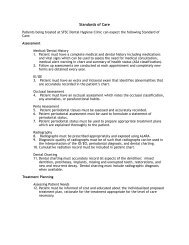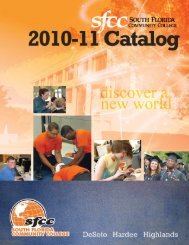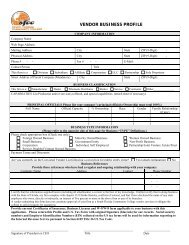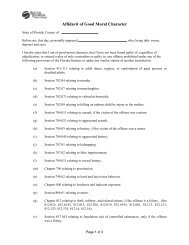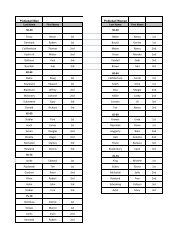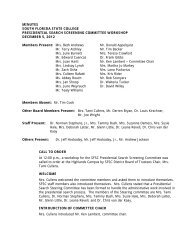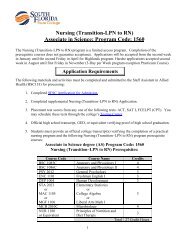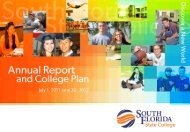SACS Compliance Certification Report (PDF) - South Florida State ...
SACS Compliance Certification Report (PDF) - South Florida State ...
SACS Compliance Certification Report (PDF) - South Florida State ...
You also want an ePaper? Increase the reach of your titles
YUMPU automatically turns print PDFs into web optimized ePapers that Google loves.
interest.The President’s Council (PC) is comprised of key administrative personnel and the Faculty Councilpresident; it serves as a decision-making body for budget, institutional effectiveness assessment,strategic planning, and policy and procedure oversight. The PC receives reports and recommendationsfrom college committees or advisory groups regarding proposals and improvement efforts that havecollege-wide implications. The PC reviews recommendations, takes action, and forwards to the DistrictBoard of Trustees as needed.The District Board of Trustees (DBOT) is highly engaged in monitoring the institutional effectivenessprocesses at the college. In December of each year, the DBOT holds a Planning Workshop where themission, vision, institutional core values, Strategic Plan, and core indicators of effectiveness are reviewedprior to planning for the next academic year. This review serves to reaffirm the institutional identity anddirection as well as providing focus to the College's mission. Following legislative allocations in May orJune of each year, the DBOT holds a Budget Workshop that reviews and approves the budget for thesubsequent fiscal year.In 2008, SFCC took an evolutionary step as the College moved away from annual goals and themes,began development of the next Strategic Plan, and established a new unit assessment format using anoutcomes focus. The new assessment process was initiated in educational programs in 2008 withadministrative units following in 2009. Through the support of technology, the Institutional EffectivenessDepartment expanded its intranet-based data repository, documentation, and distribution of reportfindings to facilitate easy access to institutional effectiveness processes for all college personnel. Newassessment committees such as the Data Assessment Group (DAG), Strategic Planning, EducationalProgram Assessment Review, Administrative Assessment Review and new assessment tools such as coreindicators of effectiveness, administrative program assessment, and educational program ssessmentresulted from this institutional effectiveness improvement effort.College-wide Assessment: Core Indicators of EffectivenessSFCC introduced the use of core indicators of effectiveness in 2008 to monitor achievement in meetingthe institutional mission (previously discussed in CR 2.4). The core indicators described by Alfred,Shults, and Seybert (2007), provide a foundation for measuring the effectiveness of colleges inaccomplishing their mission. The 16 core indicators of effectiveness include: student goal attainment,persistence, graduation rate, student satisfaction, success in subsequent and related course work,program learning outcomes and mastery of discipline, demonstration of general education competencies,regional market penetration rates, responsiveness to community needs, placement rates, licensure andcertification pass rates, employer satisfaction with graduates, client satisfaction with programs andservices, value added to the community, transfer rates, and performance after transfer. These coreindicators gauge the annual performance of the mission statement's basic components at various levels:student, program, institutional, and community. Established benchmarks are evaluated each year and, ifdeemed necessary, revised to reflect the most recent performance data. Findings stemming from theanalysis of core indicators, institutional standards, and national benchmarks are reported annually to theDBOT during the December Planning Workshop.Examples of continuing improvement in institutional quality resulting from core indicators ofeffectiveness analysis include:1. Compared SFCC performance to national benchmarks. First sets of reports caused further definitionof data being used (i.e., first time in college, how cohorts are established, differences betweendifferent study cohorts). The DAG completed an extensive assessment of college graduation ratesand determined to use the Integrated Postsecondary Education Data System (IPEDS) benchmark forcomparison.2. Involved technical departments in development of a new employer satisfaction of graduatessurvey.<strong>South</strong> <strong>Florida</strong> Community College Page 10 / 2023. Developed technical program student satisfaction survey instruments.4. Improved job placement efforts between the technical programs and the Career Planning, Placement,and Cooperative Education Center.



